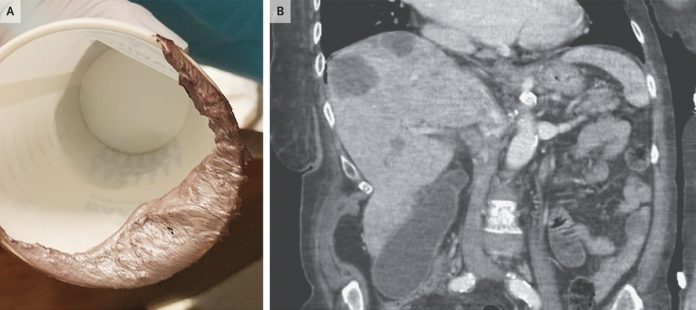A 69-year-old woman with a history of metastatic colon cancer was brought to the emergency department with complaints of dizziness and an unusual alteration in the stool colour for the past 2 weeks.
There were no other associated symptoms; neither she gave any history of itching or dark urine.
On physical examination, jaundice was noticed with hepatomegaly and diffuse tenderness in the abdomen. Silver-coloured stool was found on the digital rectal examination (Panel A).
Serological studies showed the following results:
- Hemoglobin level of 7.5 g/deciliter (Normal 11.0 to 14.5)
- Total bilirubin level of 4.0 mg/deciliter (68 μmol/liter) (Normal 0.2 to 1.3 mg/deciliter [3 to 22 μmol/L])
- Alkaline phosphatase level of 369 U/L (reference range, 45 to 117).
Stool DR was positive for occult blood.
Abdominopelvic computed tomography scan showed a cecal mass and multiple liver metastases (Panel B). Considering the advanced stage of the tumour, it was decided to start palliative care to provide comfort to the patient, so she was discharged home with hospice care.
What changed the color of the stool to silver?
Obstructive jaundice leads to pale stool, and melena (due to blood in the stool) gives black stool, the combination of these two with white stool resulted in the silver-coloured stools.
References
Malik Shehadeh, M. a. (2020, July 16). Silver Stool. Retrieved from The New England Journal of Medicine: https://www.nejm.org/doi/full/10.1056/NEJMicm2000600




